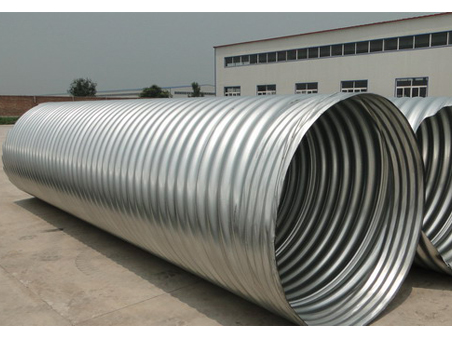Sep. 28, 2021
Corrugated steel culvert is also called the Corrugated pipe culvert, refers to the buried culvert under the highway, railway road shop with threaded Corrugated pipe, it is made from Corrugated steel coil or use the waveform spellers into circular steel structure of the steel tube.The corrugated structure of the metal corrugated pipe culvert can make the culvert pavement bear reasonable load, distribute the load evenly, and have certain anti-deformation ability, which can solve the damage problem of the bridge and concrete structure of the pipe culvert in the cold area of north China (frost).Make the road surface without expansion joint, improve the driving comfort;It is beneficial to improve the "wrong platform" phenomenon at the junction of soft soil foundation structure and embankment and improve the traffic safety.The operation and maintenance cost of bellows culvert is low, and the actual construction cost is lower than that of similar Bridges and culverts.The inlet and outlet of the steel corrugated pipe can also be made into an inclined opening according to the proportion of the slope. The pipe diameter range of the corrugated pipe is 0.5 ~ 8 m, and the thickness of the pipe wall is 3 mm ~ 7 mm, which can meet the requirements of the 0.5-40 m thickness of the soil filling.
At present, reinforced concrete arch culverts are mostly used in the form of culverts in high-fill road sections, which have the advantages of less steel consumption, strong structure, large dead weight and overload potential, and long service life, but also have a large amount of masonry and occupation Unfavorable factors such as more labor, long construction period and high requirements on foundation bearing capacity. Corrugated pipe culvert suppliers believe that compared with reinforced concrete arch culverts, steel corrugated pipe culverts have the following advantages:

Corrugated Pipe Culvert
(1) Low requirements for foundation. Since the steel corrugated pipe culvert is a flexible structure, its foundation is generally also a flexible foundation. The settlement of the culvert base and the settlement of the roadbed on both sides are uniform, so there is no need to separately treat the base of the steel corrugated pipe separately during the construction of the culvert. The principle is how to deal with the roadbed and the foundation of the culvert. Reinforced concrete arch culverts have higher requirements on the bearing capacity of the foundation. Arch culverts with a fill height of more than 12m usually require foundation bearing capacity of more than 500kPa. The soft soils in the southern region are widely distributed, and the foundation bearing capacity usually does not meet the requirements for setting arches and culverts. Strong foundation treatment schemes are needed to improve the foundation bearing capacity. After treatment, uneven settlement may still be unavoidable, leading to cracking of the arch culverts.
(2) Convenient construction. Steel bellows production, pipe assembly and civil construction can be implemented separately and simultaneously, greatly shortening the construction period. The weight of the steel bellows is only 10% to 20% of the cement products. On-site hoisting and assembling usually only take 2 to 3 weeks. There are fewer personnel and machinery involved. The construction of reinforced concrete arch culverts usually takes several months and requires a lot of manpower and material resources. At the same time, shortening the construction period will also enable the early delivery of the project and reduce public complaints caused by the construction.
(3) Better economy. Through calculation and comparison, the average cost per metre of steel corrugated pipe culverts cited in this article is about 3000 yuan lower than that of arch culverts of the same specifications, and the road sections with high fills tend to have longer culverts. Therefore, the use of steel corrugated pipe culvert can save more cost. If the construction cost of steel corrugated pipe culverts and the possible cost savings in foundation treatment are taken into account, the economic efficiency is even more considerable.
(4) Environmental protection and low carbon, reducing or radically abandoning the use of conventional building materials such as cement, sand and gravel, etc., is beneficial to environmental protection and has far-reaching significance.
Other Blog
 Highway Construction
Highway Construction  Mine Projection
Mine Projection  Municipal Engineering
Municipal Engineering  Irrigation Engineering
Irrigation Engineering  Railway Construction Projection
Railway Construction Projection  Other Application
Other Application Do you need a project solution?
With first-class products and services, and make greater contributions